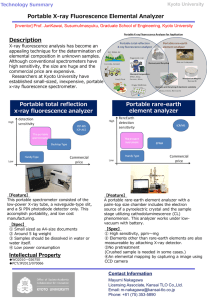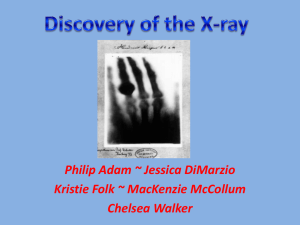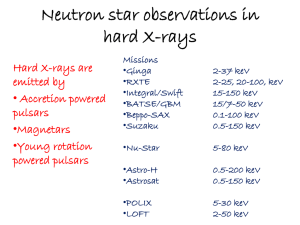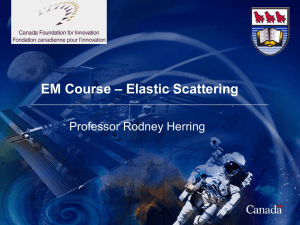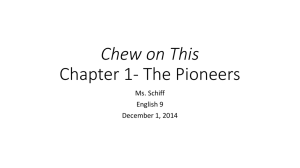slide presentation
advertisement
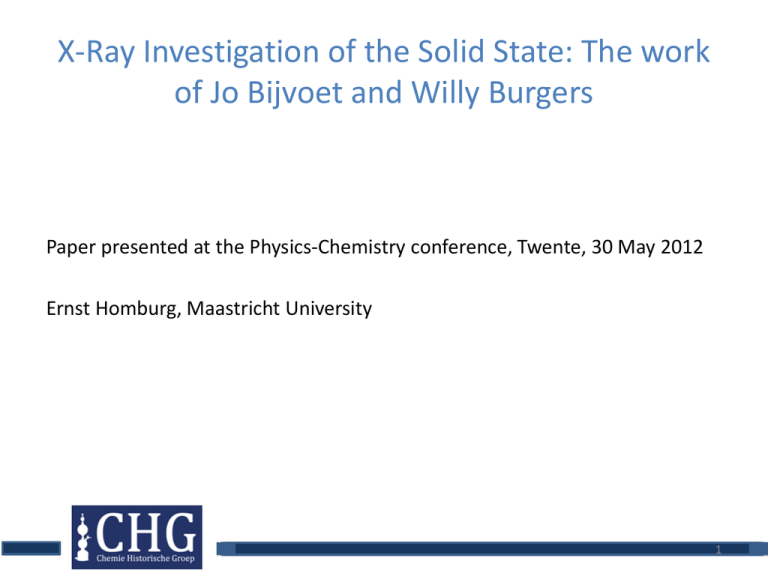
X-Ray Investigation of the Solid State: The work of Jo Bijvoet and Willy Burgers Paper presented at the Physics-Chemistry conference, Twente, 30 May 2012 Ernst Homburg, Maastricht University 1 Bijvoet (1892-1980) and Burgers (1897-1988) - Similarities * First full professors on the Netherlands focussing on X-ray structure determination - 1939 Bijvoet, Prof. General and Inorganic Chemistry, Utrecht - 1940 Burgers, Prof. Physical Chemistry, Delft * Both became actively interested in X-ray diffraction about 1919 * Both studied in England: Burgers 1924-1927 with W.H. Bragg (father) in London; Bijvoet with W.L. Bragg (son) in Manchester. 2 Bijvoet and Burgers - Differences * Social background: Bijvoet, son of a manufacturer; Burgers modest background (son of a mailman), socialist milieu * Bijvoet, started with inorganic X-ray analysis, but achieved his greatest successes in the determination of organic structures; Burgers started in organic X-ray analysis, but had a career in inorganic materials (esp. metals) * Bijvoet: purely academic career; Burgers: mixed industrial-academic career * Bijvoet: focus on solving fundamental problems; Burgers: ‘intermediary’ (semi-empirical) theories. 3 Physics leading chemistry (I) • X-ray interference: Max Laue in Munich, crystals used as a grating > investigation of X-rays. Published May-June 1912. • X-ray diffraction: W.H. Bragg and W.L. Bragg, London, a few months later: structure determination of crystals with X-rays • Snelders (1997): - Groningen school: Haga and Jaeger - Amsterdam-Utrecht school: Smits, Kolkmeyer, Bijvoet 4 Physics leading chemistry (II) • Underestimation by Snelders of the role played by Debye, Lorentz, Ehrenfest (esp.), (and Keesom) • The intertwined careers of Laue, Debye, Ehrenfest - The Sommerfeld group at Munich: Debye, 1906-1911, Laue, 1909-1912, Ehrenfest, invited 1912, as successor to Laue - Zurich: Debye 1911-1912; Laue succeeds him 1912; Ehrenfest writes PD 1911, and visits PD 1912 (during X-ray work) - Utrecht: Debye 1912-1914 > important theoretical X-ray diffraction paper - Leiden: Lorentz orchestrates his succession by Ehrenfest, 1912-1933. Keesom, Lorentz and Ehrenfest publish on X-ray diffraction - Debye and Ehrenfest: long history of interaction 1911-1933, mixed negative-positive / distanced-friendly. Very different characters. >> strong impact Sommerfeld/ Laue school in the Netherlands in 1910s 5 Peter Debye (1884-1966) • P. Debye, ‘Interferenz von Röntgenstrahlen und Wärmebewegung,’ Annalen der Physik (4) 43 (1914), 49. • P. Debye and P. Scherrer, ‘Interferenzen an regellos orientierten Teichen im Röntgenlicht,’ Göttinger Nachrichten, 1916, pp. 1, 16 • 1919: Kamerlingh Onnes blocks Debye’s appointment at Leiden • 1925: theory of X-ray diffraction of liquids and gases by P.J.W. Debye 6 Paul Ehrenfest (1880-1933) • P. Ehrenfest, ‘Over interferentieverschijnselen te verwachten wanneer Röntgenstralen door een tweeatomig gas gaan,’ Verslagen Kon. Akad. van Wetensch. 23 (1915), p. 1132. • 1919-1922: Ehrenfest stimulates W.G. Burgers to study X-ray diffraction with his friend H.J. Backer at Groningen (and F.M. Jaeger) • 1920-1930: Ehrenfest organizes the colloquia in theoretical physics at Philips NatLab. Visits by Einstein, Bragg, Langmuir, Sommerfeld, etc. • 1922: dissertation Dirk Coster on X-ray theory • 1922: collaboration with A.E. van Arkel and H.C. Burger at Philips NatLab to introduce X-ray crystallography • 1924: Epstein and Ehrenfest apply Fourier analysis and quantumtheory to X-ray diffraction. 7 Willy Burgers (1897-1988) • 1917-1919 studies chemistry at Leiden. Gets inspired by Lorentz’ lectures on X-ray crystallography of May 1916. Close contact to Ehrenfest, who is a friend of WGB’s communist bother Jan Burgers (1895-1981), a student of PE, and of JMB’s and WGB’s parents. • 1919-1920, and 1922-1924 studies at Groningen, at the advice of Ehrenfest, with H.J. Backer and F. M. Jaeger • 1924-1927 fellowships at W.H. Bragg’s Davy-Faraday lab • 1927-1940 (head of) X-ray crystallography at Philips NatLab • 1928 PhD Groningen University with Backer, on work done in London 8 X-ray research at Philips NatLab • ca. 1919 Philips starts a regular production of X-ray tubes for medical purposes. 1920 the physicist Albert Bouwer at NatLab leads research on these tubes. • 1921-1922: X-ray crystallography introduced as a technique to investigate materials, esp. metals (tungsten, etc.), by the Utrecht physicist H.C. Burger (pupil of Ornstein) • 1921 A.E. van Arkel appointed as the first chemist at NatLab. Collaborates with Burger in X-ray diffraction • Introduction of Debye-Scherrer technique into the Netherlands. • Study of deformation and recrystallisation as a result of mechanical operations (pulling tungsten wires, etc.) • 1927: Willy Burgers assistant to Van Arkel, later leader of X-ray work 9 Willy Burgers at Philips * 1927-1939: 75 publications. Mainly on plastic deformation and recrystallisation of metals, investigated by X-ray (hot lamp filaments after previous mechanical deformation – determines life time of light bulbs). Fundamental studies of these processes. * Role of lattice imperfections and dislocations * 1934-1938 the first publications (4) in the Netherlands on electron diffraction, with J.J.A. Ploos van Amstel * 1932-1939 develops with his brother Jan Burgers a theory of (screw) dislocations. Concept of the ‘Burgers vector’ (after his brother Jan) * Publishes the chapter on ‘Plasticity of Crystals’ in Roel Houwink’s important book on Elasticity, Plasticity and the Structure of Matter (1937) * 1933-1936 chairman of the Den Bosch/ Eindhoven ‘Chemische Kring’. Visits by Bijvoet. 10 Willy Burgers at Delft • 1940-1967: professor of Physical Chemistry • Continues his X-ray and electron diffraction work started at Philips. Strong continuity. • Geometrical/ qualitative approach, instead of an exact mathematical one • One of the founding father of metals research at Delft, and of the science of metals curriculum • Research: focus on fundamental research on nucleation and grain growth of crystallites (as a result of deformation, etc.) • 1972: Festschrift on ‘Topic in physical metallurgy’ by A.Q. Khan and M.J. Brabers (his student Khan = of Kistemaker/ Pakistan fame) 11 Jo Bijvoet (1892-1980) • 1910-1914, 1918-1919: studies chemistry at Amsterdam, with Andreas Smits and J.D. van der Waals Jr. (thermodynamics) • 1914-1918, military service. Studies J.W. Gibbs’ chemical thermodynamics • 1919-1923, assistant to Andreas Smits. Studies 1919-1920 X-ray crystallography with Keesom and Kolkmeijer at Utrecht • 1920-etc.: introduced X-ray crystallography at Amsterdam • 1923: PhD on X-ray crystallography with Smits. Dissertation in English. Then very unusual. • 1926: work a few months with W.L. Bragg at Manchester 12 Jo Bijvoet (II) • 1926-1939 very problematic career as assistant, and ‘private lecturer’, and reader at the University of Amsterdam. Opposition by the Prof. of geology and mineralogy H.A. Brouwer (brother of the mathematician L.E.J.) • 1928 first Dutch textbook on X-ray crystallography by Kolkmeijer, Bijvoet and Karssen • 1928 Bijvoet is the first Dutchmen to apply Fourier analysis to the determination of crystal structures • Almost no budget for research, due to Brouwer, and (partly) therefore increasing focus on theory • Introduced modern quantumchemistry, chemical thermodynamics, etc. into the Netherlands. Admired lecturer • 1939-1962 Professor at Utrecht: formation of a school (incl. Amsterdam: Ketelaar, MacGillavry, Wiebinga, Peerdeman) 13 Absolute configuration by direct methods • Phase problem: trial-and-error procedure impossible for complicated molecules. Fournier analyses introduced the ‘phase problem’. Bijvoet build on the contributions by Patterson and Slater (1934) • Isomorphic replacement by ‘heavy atoms’ (1936): succinic acid (first organic substance investigated) • 1940 Bijvoet combined Patterson’s (Fourier) synthesis with Robertson’s isomorphic replacement: camphor-derivatives; after 1947 strychine as the first non-centrosymmetrical molecular structure ever determined; but complicated • 1948: Bijvoet realized that anomalous scattering (Dirk Coster on ZnS in 1930) would give the possibility to determine absolute configuration. 1950: determination of the absolute configuration of a salt of tartaric acid by Bijvoet, Peerdeman and Van Bommel • 1955: absolute configuration of amino acid tyrosine by B’s group 14 Conclusion • Great role of physicists in the early years of chemical crystallography • The leaders combined (German) theoretical influences with British experimental methods • Burgers and Bijvoet had very different scientific ‘styles’ • Influences of ‘milieu’ and industrial/ academic environments? 15

